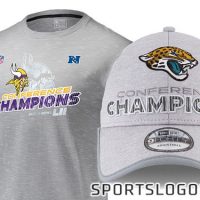On a recent episode of Dan Patrick Show, guest Josh Duhamel, noted actor, handsome person, and husband of the Black Eyed Peas’ Fergie, lamented that his Minnesota Vikings “get less press than any other team.” We here at SportsLogos.net are all about listening to the needs of the public, especially when that public played Leo du Pres on All My Children, so we thought we’d look into the story behind the Vikings’ nickname.
The Vikings were established January 28, 1960, at the league owners’ meeting in Miami, to begin play in 1961. In August 1960, they brought in former public relations manager of the Los Angeles Rams Bert Rose to be the team’s general manager.
According to information provided by Jon Ekstrom, the Vikings’ public relations manager: “In one of his first moves with the team, Bert Rose recommended the nickname ‘Vikings‘ to the Board of Directors. The name was selected because it represented both an aggressive person with the will to win and the Nordic tradition in the northern Midwest.”

One of the reasons Rose recommended the nickname was likely as an homage to the legendary Oluf “Ole” Haugsrud, who owned 10 percent of the Vikings and was once credited by NFL President Joe Carr with “saving the NFL” when the league was in its infancy.
Haugsrud had previously owned the Duluth Eskimos, a barnstorming team that played in 1926 to 1927. The traveling team is credited with building the popularity of the new league when it was just getting started. (Though it’s never stated explicitly in the film, the George Clooney movie Leatherheads is based on the Eskimos.)
Haugsrud sold the team to the NFL, but as part of an agreement, was offered the opportunity to become part owner of any future NFL franchise that played in Minnesota. He turned down that opportunity when the ultimately short-lived Minneapolis Red Jackets came to town in 1929, but opted in when the NFL awarded Minnesota a franchise in 1960.
Haugsrud’s high school alma mater was the Superior Central Vikings in Superior, Wisconsin, a team whose colors were purple and gold, a name and color scheme that certainly look familiar to fans of the Minnesota Vikings.
The name itself—whether it’s for a high school in neighboring Wisconsin or an NFL team in Minnesota—comes from the distinct and noted influence of northern Europe’s coldest places in the state: Minnesota has the highest percentage of Scandinavian-Americans in the nation. As the New York Times puts it, “There’s no escaping Scandinavian heritage in the Twin Cities. At every turn, there’s a billboard for Norwegian language-immersion camp or a ‘Drool if You’re Finnish’ baby bib for sale.”
If you’re going to promote a sports team to a Scandinavian population, the fiercest and most appropriate nickname has to be the Viking. The age of the Vikings ranged from the late 700s into the 11th century, when boatsmen from modern-day Denmark, Norway, and Sweden would attack and plunder pretty much anything, beginning in the year 793 with a monastery in Northumberland, England, looking for riches.

One thing to note about that Minnesota Vikings logo, though, is that according to the website Norse Mythology, there’s no record of actual Viking raiders ever wearing horns on their helmets. They wore leather helmets that actually look more like the ones the old Duluth Eskimos wore than the ones depicted in the Vikings’ logo. The myth of the Viking horn might have come later in an attempt to make them look evil or as a bastardization of the wings on the Norse god Thor’s helmet.
The history of Vikings is a little more nuanced than the violent barbarian of the stereotype—many were peaceful settlers and farmers in places like England, Iceland, and Greenland, to name a few—but those who took to the sea in search of riches earned a certain reputation. These raids began in a hit-and-run style, then with success and expansion, the Vikings started invading and setting up camp in the places they were attacking.
The Scandinavian expansion into the world wouldn’t hit current-day Minnesota in significant numbers until the 1800s, but when it did, it did so with a flourish, and is a major part of the culture today—not just in lingonberries and cured fish, but with a distinct logo for the local football team.














